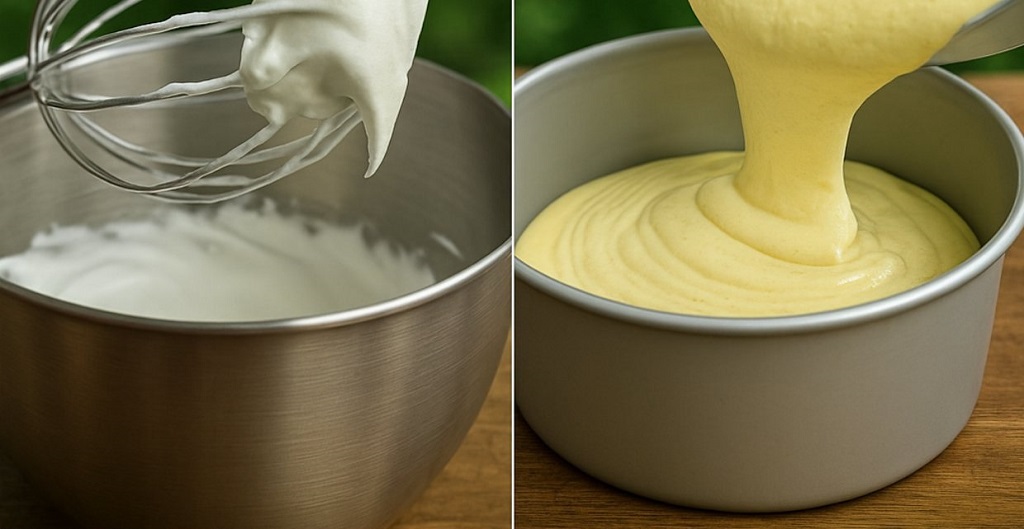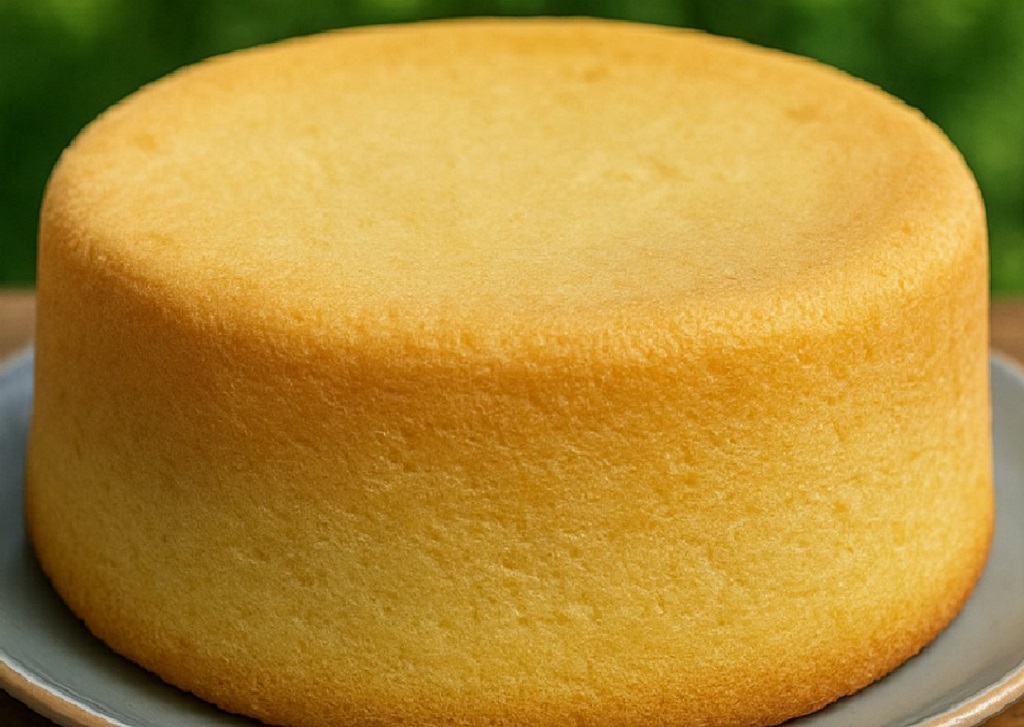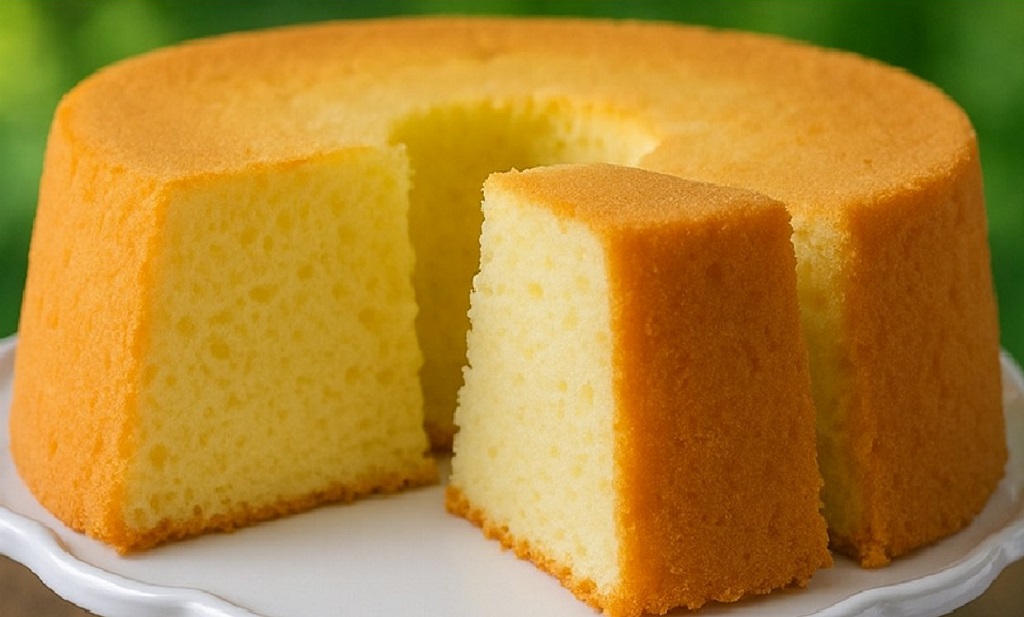When I want a cake that feels like a cloud but still holds a rich, satisfying flavor, I always turn to chiffon cake. As a professional chef who’s baked everything from buttery pound cakes to the lightest Japanese cheesecakes, chiffon cake holds a special place in my heart. It’s the perfect balance of airy sponge and moist richness the best of both worlds.
“Chiffon cake isn’t just a dessert. It’s the art of air captured inside a cake.” – @AiryBakesMaster
Why Chiffon Cake is a Must Bake
Chiffon cake is like a cross between a traditional sponge cake and a rich butter cake. It’s incredibly light because of the whipped egg whites, yet has a tender, moist crumb thanks to the addition of oil. It’s the kind of cake that feels fancy enough for celebrations but simple enough for everyday baking.
- Fluffy and Moist: Whipped egg whites lift the batter while the oil keeps it soft and tender.
- Neutral Base: Easily flavored with vanilla, lemon, orange zest, or cocoa.
- Showstopping Presentation: Tall, golden, and elegant enough for birthdays or special occasions.
- Pairs Perfectly: Serve plain, dusted with powdered sugar, or topped with whipped cream and berries.
Just like our castella sponge cake or Japanese cheesecake, chiffon cake celebrates the beauty of simple ingredients and careful technique.
My Journey to Perfecting Chiffon Cake
When I first started baking chiffon cakes, I struggled with cakes that sank or turned out dense. I learned the hard way that mastering chiffon is all about respecting the delicate balance of air and structure. Separating the eggs cleanly, beating the whites to stiff but not dry peaks, and folding with patience made all the difference.
Now, making a perfect chiffon feels natural, much like crafting a batch of fluffy milk buns it’s about developing a rhythm and trusting the process.
Ingredients You’ll Need
- 7 fresh eggs, separated
- 1 cup granulated sugar
- ½ cup vegetable oil
- ¼ cup water
- 1 teaspoon vanilla extract
- 1¾ cups cake flour
- 1 tablespoon baking powder
- ½ teaspoon salt
The ingredients are straightforward, but the magic lies in how you handle them. It’s similar to how simple ingredients in our easy crepes transform into something exquisite when treated carefully.
Step by Step Guide to Making Chiffon Cake
1: Preheat and Prep
- Preheat your oven to 325°F (165°C).
- Line the bottom of a 10 inch tube pan with parchment paper. Do not grease the pan the batter needs to cling to the sides to rise properly.
2: Make the Yolky Base
- In a large bowl, whisk together the egg yolks and ¾ cup of the sugar until thick and pale.
- Add the vegetable oil, water, and vanilla extract, mixing until smooth and fully combined.
3: Sift and Fold
- Sift the cake flour, baking powder, and salt directly into the wet mixture.
- Gently whisk until smooth. Take your time to avoid lumps but do not overmix.
4: Beat the Egg Whites
- In a separate clean bowl (absolutely free of any grease), beat the egg whites until frothy.
- Gradually add the remaining ¼ cup of sugar and continue beating until stiff peaks form glossy and firm, but not dry.
5: Fold Carefully
- Fold one third of the beaten egg whites into the batter to lighten it.
- Gently fold in the remaining egg whites in two more additions, being careful not to deflate the air bubbles.
6: Bake and Cool
- Pour the batter into the prepared tube pan and smooth the top.
- Bake for 55-60 minutes until golden and a toothpick inserted into the center comes out clean.
- Immediately invert the pan onto a cooling rack and let the cake cool completely upside down before removing.
“Patience is the last ingredient. Don’t rush cooling it’s what gives the chiffon its height and lightness.” – @PatienceInBaking

Chef’s Tips for Chiffon Cake Success
Attention to Detail Makes All the Difference
- Clean Tools: Ensure your egg white bowl and beaters are perfectly clean even a drop of fat prevents proper whipping.
- Room Temperature Eggs: They whip more easily and incorporate air better, just like in recipes like moist yogurt cakes.
- Gentle Folding: Use a spatula and slow, sweeping motions from bottom to top to preserve the air.
- Cool Upside Down: It prevents the cake from collapsing under its own weight as it cools.
Chiffon cake rewards bakers who are patient, gentle, and respectful of the process values I bring to every bake, whether I’m making simple breads or sophisticated desserts.
“Baking is listening. Listen to the batter, the oven, the scent filling the kitchen. It tells you when it’s ready.” – @BakeWhisperer
Flavor Variations to Transform Your Chiffon Cake
Small Changes, Big Impact
While the classic vanilla chiffon cake is beautiful on its own, I love experimenting with different flavors depending on the season or the occasion. Chiffon cakes are like blank canvases incredibly receptive to subtle twists that bring out new personalities:
- Lemon Chiffon: Add 1 tablespoon of fresh lemon zest and replace the water with lemon juice for a bright, zesty flavor, similar to our zesty lemon cake.
- Orange Blossom: Use orange juice instead of water and a teaspoon of orange extract to infuse a soft citrus aroma.
- Matcha Chiffon: Sift 2 tablespoons of matcha powder into the dry ingredients for a delicate green tea twist.
- Chocolate Chiffon: Replace ¼ cup of flour with cocoa powder for a rich chocolate version, like a lighter take on our fluffy chocolate cheesecakes.
- Almond Dream: Swap vanilla extract with almond extract for a nutty, sophisticated flavor.
“Baking is like painting. The base stays the same it’s the accents you choose that create a masterpiece.” – @CanvasBaker
Common Mistakes to Avoid When Baking Chiffon Cake
Lessons Learned from Trial and Error
Chiffon cake might seem intimidating, but most problems come from just a few common mistakes. I learned the hard way that careful attention at every step prevents disappointment:
- Deflated Batter: Folding the egg whites too aggressively will collapse the air bubbles, leading to a dense cake.
- Greased Pan: Never grease the tube pan. The batter needs to cling to the sides to rise tall and proud.
- Undermixed Yolks: Beating the yolks until pale and thick is crucial. It builds a strong, stable base for the cake.
- Incorrect Cooling: Always cool the cake upside down. If not, gravity pulls it down and ruins the airy texture.
It’s the same precision and patience I use when baking structured breads like fluffy brioche respect the science, and you’ll reap the rewards.
“Baking isn’t about controlling the process. It’s about guiding it, respecting its rules.” – @OvenWhisperer
Best Ways to Serve Chiffon Cake
From Simple to Spectacular
Chiffon cake is delightfully versatile when it comes to serving. Its gentle sweetness and light crumb make it the perfect companion for all kinds of toppings and pairings:
- Powdered Sugar Dusting: Keep it classic and simple with a light dusting of powdered sugar.
- Fresh Berries: Serve with strawberries, blueberries, or raspberries for a fresh burst of color and flavor, like with our strawberry desserts.
- Whipped Cream: A generous dollop of lightly sweetened whipped cream brings a luscious, silky contrast.
- Citrus Glaze: Whisk together powdered sugar and lemon or orange juice for a quick glaze that adds a bright finishing touch.
- Layered with Custard: Slice the cake horizontally and sandwich layers with vanilla custard or lemon curd for an elevated dessert experience.
I love creating simple, elegant dessert plates with chiffon just like with easy homemade crepes minimal effort, maximum beauty.
“Serve simply. Serve beautifully. Let the cake speak for itself.” – @MinimalistBakerArt
Quick Troubleshooting for Chiffon Cake
| Problem | Cause | Solution |
|---|---|---|
| Cake deflates or shrinks | Egg whites folded too roughly or underbaked | Fold gently and bake fully before removing |
| Cake sticks to the pan badly | Incorrect cooling or unlined bottom | Always invert immediately after baking and use parchment at the bottom only |
| Dense, gummy texture | Overmixing or underbeaten egg whites | Mix batter gently and beat whites to stiff peaks |
| Dry crumb | Overbaking or low humidity in oven | Check early and bake just until toothpick comes out clean |
| Large air pockets inside | Underfolded meringue leaving pockets | Fold completely but gently to fully incorporate egg whites |
With careful folding, correct baking time, and a gentle hand, your chiffon will come out perfect every single time just like mastering a beautiful loaf of homemade bread after practice.
“Practice patience, precision, and passion. That’s how you turn eggs, flour, and air into magic.” – @MagicBaker
Pro Tips for Chiffon Cake Mastery
Advanced Techniques from a Chef’s Kitchen
Once you’ve mastered the basics, these professional baker secrets can elevate your chiffon cake from good to truly unforgettable. I use these techniques every time I want my chiffon cakes to be competition worthy:
- Double Sift Dry Ingredients: Sifting twice aerates the flour and guarantees a finer, lighter crumb.
- Whip Egg Whites Slowly: Start at medium speed and increase gradually. Slow whipping builds stronger, more stable air bubbles.
- Use Cake Flour Only: Cake flour’s lower protein content ensures a delicate, tender cake structure, much like when making classic sponge cakes.
- Weigh Ingredients: For maximum precision, use a kitchen scale rather than volume measurements, especially for flour and sugar.
- Cool Gradually: After inverting, leave the cake untouched until fully cooled to avoid collapse or tearing.
It’s the same attention to detail that perfects soft breads like our crescent donuts tiny tweaks create enormous results over time.
“Baking chiffon cake is a conversation between patience and precision. Listen carefully, and it will reward you with perfection.” – @ChiffonWhisperer
How to Perfect the Texture of Chiffon Cake
The Balance Between Airiness and Moisture
Creating the perfect chiffon cake is about mastering the balance between airiness and moisture. After baking hundreds of chiffon cakes in my kitchen, I realized that controlling texture comes down to a few simple but essential techniques:
- Precise Egg Separation: Even a tiny speck of yolk can prevent your egg whites from whipping properly. Separate eggs carefully, one at a time, into a small bowl before adding to the larger mixing bowl.
- Correct Whipping Stage: Beat egg whites until they form stiff, glossy peaks not soft peaks and not overwhipped dry peaks. This ensures the cake rises high without collapsing.
- Oil Instead of Butter: Using oil instead of butter helps create a more moist, tender crumb, giving that beautiful melt in your mouth texture much like our yogurt cake.
- Low and Slow Baking: Chiffon cake needs a gentle, steady bake at lower temperatures to avoid sudden expansion and collapse.
The same delicate attention is needed when making beautifully soft desserts like Japanese cheesecake, where texture is everything.
“Texture isn’t luck it’s the reward for being gentle, patient, and deliberate at every step.” – @TextureCraftsman
Small Adjustments for Flawless Rise
Want that tall, proud chiffon with a perfect golden dome? Here’s what I recommend after years of trials:
- Do Not Grease the Pan: The batter must grip the sides of the ungreased tube pan to climb high and maintain structure.
- Use the Right Pan: A two piece aluminum tube pan is best it distributes heat evenly and allows the cake to cling and cool upside down without collapsing.
- Tap Out Bubbles: Lightly tap the pan on the counter before baking to remove any large air pockets that could create tunnels.
Following these simple adjustments reminds me of refining my dough when baking soft breads like fluffy milk buns small changes, huge results.
“Rise isn’t about forcing. It’s about creating the perfect environment for the batter to lift itself.” – @RiseAndShineBakes
Enhancing Chiffon Cake with Fillings and Toppings
Dress It Up for Special Occasions
While chiffon cake is stunning even plain, there are endless ways to elevate it for holidays, birthdays, or elegant afternoon teas. Over the years, I’ve loved experimenting with these additions:
- Whipped Cream Filling: Slice the cake horizontally and fill it with softly whipped cream and fresh berries, much like assembling a berry cheesecake.
- Lemon Curd: Add a tangy layer of lemon curd between cake layers for a refreshing contrast to the sweet crumb.
- Chocolate Ganache: Pour a silky chocolate ganache over the top for an ultra indulgent finish.
- Glazed Fruit: Top with a layer of glazed fresh fruits like kiwi, strawberries, or blueberries for a colorful presentation.
Sometimes even a simple dusting of powdered sugar transforms a chiffon into an elegant centerpiece similar to the magic we create when finishing a plate of crepes with berries and cream.
“Simple doesn’t mean plain. One thoughtful garnish can turn humble into unforgettable.” – @GarnishWhisperer
Flavor Infusion Ideas for Chiffon Cake
Here’s a quick cheat sheet I use when deciding how to flavor my chiffon cakes depending on the season or theme:
| Flavor Theme | What to Add | Best Pairings |
|---|---|---|
| Lemon Sunshine | Lemon zest + replace water with lemon juice | Whipped cream, fresh berries |
| Chocolate Indulgence | Replace ¼ cup flour with cocoa powder | Chocolate glaze, ganache drizzle |
| Tropical Vibes | Replace water with coconut milk, add shredded coconut | Pineapple slices, coconut whipped cream |
| Matcha Serenity | 2 tablespoons sifted matcha powder | Red bean paste, whipped cream |
| Almond Dream | Swap vanilla for almond extract | Toasted almonds, powdered sugar |
It’s the same creative thinking that helps us take classics like pineapple quick bread and give them exciting new twists.
“Flavor is a feeling. Bake the cake you want to taste in your memories.” – @FlavorMemoryBaker
Storage and Make Ahead Tips for Busy Bakers
Keeping Chiffon Cake Fresh and Delicious
Chiffon cake is delicate but it holds up beautifully when stored properly. Whether you’re preparing for an event or just want to savor it over a few days, here’s my personal method for keeping it at peak perfection:
- Room Temperature: Store wrapped tightly in plastic wrap or an airtight container for up to 3 days. Keep it away from direct sunlight or heat sources.
- Refrigeration: Refrigerate only if filled with whipped cream, custard, or curd. Bring to room temperature before serving to restore its soft crumb.
- Freezing: Freeze whole or sliced chiffon cakes wrapped tightly in plastic and foil for up to 2 months. Thaw overnight at room temperature, uncovered, to prevent condensation.
- Refreshing the Texture: A very light mist of water on slices before warming gently in the microwave for 10 seconds can revive slight dryness.
These smart storage strategies are just like handling soft breads like our hot cross buns attention to moisture and airflow makes all the difference.
“Treat your chiffon cake like a delicate flower. Protect it, nurture it, and it will reward you every time you slice.” – @CakeCareMaster
Frequently Asked Questions About Chiffon Cake
Can I use all purpose flour instead of cake flour?
Technically yes, but the texture will be denser. If you must use all purpose flour, remove 2 tablespoons of flour per cup and replace with 2 tablespoons of cornstarch to mimic cake flour.
Why do I need to cool the chiffon cake upside down?
Cooling upside down prevents the delicate structure from collapsing under its own weight, preserving that tall, airy rise.
Can I add flavors like chocolate or coffee to the batter?
Absolutely! Replace a portion of the flour with cocoa powder for chocolate chiffon, or dissolve 1 tablespoon of instant coffee in the water for a coffee version.
Why is my cake dry?
Dryness usually means it was overbaked or the batter was overmixed. Always check early and fold carefully to preserve moisture.
What if I don’t have a tube pan?
A bundt pan can work in a pinch, but the tube pan’s straight sides and removable bottom are ideal. Avoid non stick pans for chiffon cakes.
How do I store chiffon cake?
Keep it covered at room temperature for up to 3 days. You can refrigerate it for up to 5 days, but bring it to room temperature before serving for the best texture.
Can I freeze chiffon cake?
Yes! Wrap slices tightly in plastic wrap and freeze for up to 2 months. Thaw at room temperature and dust with powdered sugar before serving.
How stiff should the egg whites be?
Beat until stiff, glossy peaks form. They should hold their shape without drooping but still look smooth, not dry or curdled.
Why did my chiffon cake fall after baking?
Falling is often caused by underbaking, rough folding, or greasing the pan. Always bake fully, fold gently, and leave the pan ungreased.
Is chiffon cake healthier than butter cakes?
Chiffon cakes are lower in fat compared to traditional butter cakes because they use oil and whipped egg whites for lift, making them lighter and airier.
“Every question you ask brings you closer to baking mastery. Curiosity builds better cakes.” – @CuriousBakerLife

